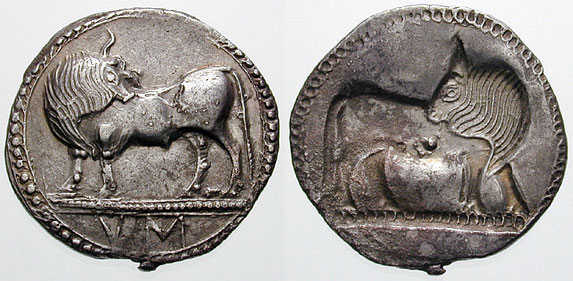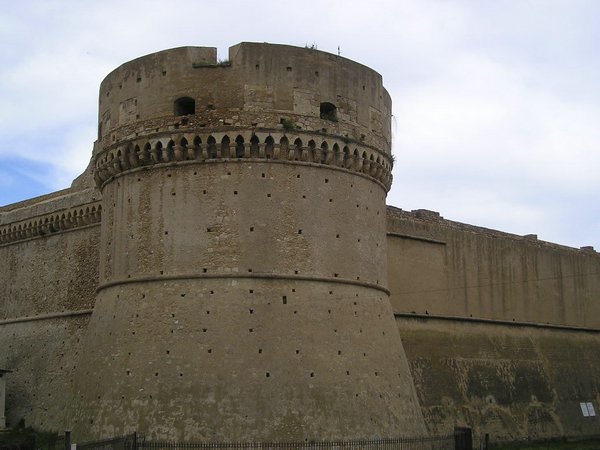|
Scidrus
Scidrus, also known as Skidros ( grc, Σκίδρος), was an ancient Greek city on the coast of Lucania, on the Tyrrhenian Sea, between Pyxus (Buxentum) and Laüs. History It is mentioned only by Herodotus (vi. 21), from whom we learn that it was, as well as Laüs, a colony of Sybaris, and was one of the places to which the surviving inhabitants of that city retired, after its destruction by the Crotoniats. It does not appear from his expressions whether these towns were then first founded by the fugitives, or had been previously settled as regular colonies; but the latter supposition is much the more probable. It is singular that no subsequent trace is found of Scidrus; its name is never again mentioned in history, nor alluded to by the geographers, with the exception of Stephanus of Byzantium (''s. v.''), who calls it merely a city of Italy. We have therefore no clue to its position; for even its situation on the Tyrrhenian Sea is a mere inference from the manner in which it is ... [...More Info...] [...Related Items...] OR: [Wikipedia] [Google] [Baidu] |
Sybaris
Sybaris ( grc, Σύβαρις; it, Sibari) was an important city of Magna Graecia. It was situated in modern Calabria, in southern Italy, between two rivers, the Crathis ( Crati) and the Sybaris ( Coscile). The city was founded in 720 BC by Achaean and Troezenian settlers. Sybaris amassed great wealth thanks to its fertile land and busy port. Its inhabitants became famous among the Greeks for their hedonism, feasts, and excesses, to the extent that "sybarite" and "sybaritic" have become bywords for opulence, luxury, and outrageous pleasure-seeking. In 510/509 BC the city was subjugated by its neighbor Kroton and its population driven out. Sybaris became a dependent ally of Kroton, but Kroton again besieged the city in 476/475 BC, probably resulting in another victory for Kroton. Two attempts to reoccupy the city failed around 452/451 BC and 446/445 BC when the remaining Sybarites were again expelled by the Krotoniates. After a call for help the Sy ... [...More Info...] [...Related Items...] OR: [Wikipedia] [Google] [Baidu] |
Laüs
Laüs or Laus ( grc, Λᾶος; it, Laos) was an ancient city of Magna Graecia on the coast of the Tyrrhenian Sea. It was a colony of Sybaris at the mouth of the Lao River, Italy, Lao River, which formed the boundary between Lucania and Bruttium in ancient times. The river and the city have the same name in Ancient Greek. Today the archaeological site of the city can be found at a short distance to the east of Marcellina, a ''frazione'' of the ''comune'' of Santa Maria del Cedro in Calabria. History Little is known about its foundation or history. Herodotus states that the inhabitants of Sybaris who had survived the destruction of their city in 510 BCE took refuge in Laüs and Scidrus. Diodorus Siculus seems to imply that that city had been captured by the Lucani (ancient people), Lucanians before or during 390 BCE. He writes that the army of Thurii had repelled a force of the Lucanians which had attacked their territory in 390 BCE. The Lucanians then withdrew to ... [...More Info...] [...Related Items...] OR: [Wikipedia] [Google] [Baidu] |
Ancient Greece
Ancient Greece ( el, Ἑλλάς, Hellás) was a northeastern Mediterranean civilization, existing from the Greek Dark Ages of the 12th–9th centuries BC to the end of classical antiquity ( AD 600), that comprised a loose collection of culturally and linguistically related city-states and other territories. Most of these regions were officially unified only once, for 13 years, under Alexander the Great's empire from 336 to 323 BC (though this excludes a number of Greek city-states free from Alexander's jurisdiction in the western Mediterranean, around the Black Sea, Cyprus, and Cyrenaica). In Western history, the era of classical antiquity was immediately followed by the Early Middle Ages and the Byzantine period. Roughly three centuries after the Late Bronze Age collapse of Mycenaean Greece, Greek urban poleis began to form in the 8th century BC, ushering in the Archaic period and the colonization of the Mediterranean Basin. This was followed by the age of Classica ... [...More Info...] [...Related Items...] OR: [Wikipedia] [Google] [Baidu] |
Lucania
Lucania was a historical region of Southern Italy. It was the land of the Lucani, an Oscan people. It extended from the Tyrrhenian Sea to the Gulf of Taranto. It bordered with Samnium and Campania in the north, Apulia in the east, and Bruttium in the south-west, and was at the tip of the peninsula which is now called Calabria. It thus comprised almost all the modern region of Basilicata, the southern part of the Province of Salerno (the Cilento area) and a northern portion of the Province of Cosenza. The precise limits were the river Silarus in the north-west, which separated it from Campania, and the Bradanus which flows into the Gulf of Taranto in the east. The lower tract of the river Laus, which flows from a ridge of the Apennine Mountains to the Tyrrhenian Sea in an east-west direction, marked part of the border with Bruttium. Regions of Italy Geography Almost the whole area is occupied by the Apennine Mountains, which here are an irregular group of lofty masse ... [...More Info...] [...Related Items...] OR: [Wikipedia] [Google] [Baidu] |
Tyrrhenian Sea
The Tyrrhenian Sea (; it, Mar Tirreno , french: Mer Tyrrhénienne , sc, Mare Tirrenu, co, Mari Tirrenu, scn, Mari Tirrenu, nap, Mare Tirreno) is part of the Mediterranean Sea off the western coast of Italy. It is named for the Tyrrhenian people identified with the Etruscans of Italy. Geography The sea is bounded by the islands of Corsica and Sardinia (to the west), the Italian Peninsula (regions of Tuscany, Lazio, Campania, Basilicata, and Calabria) to the north and east, and the island of Sicily (to the south). The Tyrrhenian Sea also includes a number of smaller islands like Capri, Elba, Ischia, and Ustica. The maximum depth of the sea is . The Tyrrhenian Sea is situated near where the African and Eurasian Plates meet; therefore mountain chains and active volcanoes such as Mount Marsili are found in its depths. The eight Aeolian Islands and Ustica are located in the southern part of the sea, north of Sicily. Extent The International Hydrographic Organiza ... [...More Info...] [...Related Items...] OR: [Wikipedia] [Google] [Baidu] |
Pyxus
Policastro Bussentino (or simply Policastro) is an Italian town and hamlet (''frazione'') of the municipality of Santa Marina (of which it is its seat) in the province of Salerno, Campania region. It is a former bishopric, now titular see, and has a population of 1,625. History The town was founded in 470 or 471 BC as ''Pixous'' ( grc, Πυξοῦς), by Micythus ( grc, Μίκυθος), the tyrant of Rhegion and Messena. It has been a Latin Rite bishopric twice, as Bussento ( la, Buxentum) and as Policastro, and remains a Catholic titular see as "Capo della Foresta". During the fascist period, with the union of municipalities of Ispani and Santa Marina, Policastro became a hamlet of Capitello. Geography The town is located on the southern side of Cilento, not too far from the national park, in the middle of the Gulf of Policastro on the Tyrrhenian Sea. Situated by the estuary of river Bussento, it is 10 km far (north) from Sapri, 5 from Santa Marina, 4 from Scari ... [...More Info...] [...Related Items...] OR: [Wikipedia] [Google] [Baidu] |
Herodotus
Herodotus ( ; grc, , }; BC) was an ancient Greek historian and geographer from the Greek city of Halicarnassus, part of the Persian Empire (now Bodrum, Turkey) and a later citizen of Thurii in modern Calabria ( Italy). He is known for having written the ''Histories'' – a detailed account of the Greco-Persian Wars. Herodotus was the first writer to perform systematic investigation of historical events. He is referred to as " The Father of History", a title conferred on him by the ancient Roman orator Cicero. The ''Histories'' primarily cover the lives of prominent kings and famous battles such as Marathon, Thermopylae, Artemisium, Salamis, Plataea, and Mycale. His work deviates from the main topics to provide a cultural, ethnographical, geographical, and historiographical background that forms an essential part of the narrative and provides readers with a wellspring of additional information. Herodotus has been criticized for his inclusion of "legends and fa ... [...More Info...] [...Related Items...] OR: [Wikipedia] [Google] [Baidu] |
Crotona
Crotone (, ; nap, label= Crotonese, Cutrone or ) is a city and ''comune'' in Calabria, Italy. Founded as the Achaean colony of Kroton ( grc, Κρότων or ; la, Crotona) in Magna Graecia, it was known as Cotrone from the Middle Ages until 1928, when its name was changed to the current one. In 1992, it became the capital of the newly established Province of Crotone. , its population was about 65,000. History Croton's '' oikistes'' (founder) was Myscellus, who came from the city of Rhypes in Achaea in the northern Peloponnese. He established the city in c. 710 BC and it soon became one of the most flourishing cities of Magna Graecia with a population between 50,000 and 80,000 around 500 BC. Its inhabitants were famous for their physical strength and for the simple sobriety of their lives. From 588 BC onwards, Croton produced many generations of winners in the Olympics and the other Panhellenic Games, the most famous of whom was Milo of Croton. According to Herodotus (3.1 ... [...More Info...] [...Related Items...] OR: [Wikipedia] [Google] [Baidu] |
Stephanus Of Byzantium
Stephanus or Stephan of Byzantium ( la, Stephanus Byzantinus; grc-gre, Στέφανος Βυζάντιος, ''Stéphanos Byzántios''; centuryAD), was a Byzantine grammarian and the author of an important geographical dictionary entitled ''Ethnica'' (). Only meagre fragments of the dictionary survive, but the epitome is extant, compiled by one Hermolaus, not otherwise identified. Life Nothing is known about the life of Stephanus, except that he was a Greek grammarian who was active in Constantinople, and lived after the time of Arcadius and Honorius, and before that of Justinian II. Later writers provide no information about him, but they do note that the work was later reduced to an epitome by a certain Hermolaus, who dedicated his epitome to Justinian; whether the first or second emperor of that name is meant is disputed, but it seems probable that Stephanus flourished in Byzantium in the earlier part of the sixth century AD, under Justinian I. The ''Ethnica'' Even as a ... [...More Info...] [...Related Items...] OR: [Wikipedia] [Google] [Baidu] |
Italy
Italy ( it, Italia ), officially the Italian Republic, ) or the Republic of Italy, is a country in Southern Europe. It is located in the middle of the Mediterranean Sea, and its territory largely coincides with the homonymous geographical region. Italy is also considered part of Western Europe, and shares land borders with France, Switzerland, Austria, Slovenia and the enclaved microstates of Vatican City and San Marino. It has a territorial exclave in Switzerland, Campione. Italy covers an area of , with a population of over 60 million. It is the third-most populous member state of the European Union, the sixth-most populous country in Europe, and the tenth-largest country in the continent by land area. Italy's capital and largest city is Rome. Italy was the native place of many civilizations such as the Italic peoples and the Etruscans, while due to its central geographic location in Southern Europe and the Mediterranean, the country has also historically b ... [...More Info...] [...Related Items...] OR: [Wikipedia] [Google] [Baidu] |
Sapri
Sapri is a town and ''comune'' in the province of Salerno in the Campania region of south-western Italy. It is one of the southernmost towns of the region of Cilento and its population is 6,783.Source Istat 2011 History In June–July 1857 the republican revolutionary Carlo Pisacane led the Sapri expedition her ...[...More Info...] [...Related Items...] OR: [Wikipedia] [Google] [Baidu] |


.jpg)




